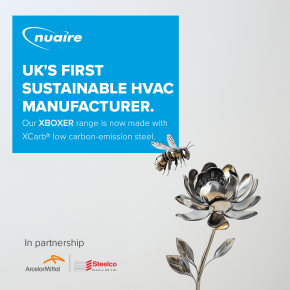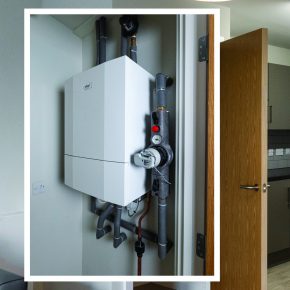
What is COP and EER? Glen Dimplex investigate…
What is COP and EER and how do they affect the choice of energy efficient HVAC technology designed to reduce carbon emissions and achieve compliance? GDHV investigate…
What is COP and EER?
The Coefficient of Performance (COP) and Energy Efficiency Ratio (EER) are measures of a heat pump or heating and cooling solution’s efficiency. They indicate a ratio of useful heating or cooling produced by the unit against the energy it consumes. For example, the COP of a heat pump that can provide 3kW of heat against the input of 1kW of electricity is 3. The EER that generates a cooling effect of 12BTU against the input of 1kW of electricity is 12.
Can COP and EER be used to establish the overall energy efficiency of a heating or cooling unit
In simple terms, the higher the COP or EER, the more energy efficient the heat pump is. This is helpful as a relatively simple efficiency qualifier calculated as a punctual value at a given condition. As we know, however, the energy efficiency of heat pumps can change based on many factors, including for example variations in external temperatures, such as those from seasons.
The load requirement for heat pumps also changes, especially in temperate climates such as the UK. The Seasonal Coefficient of Performance (SCOP) and Seasonal Energy Efficiency Ratio (SEER) consider the energy efficiency of a heat pump throughout the entire heating and cooling season, providing a more accurate comparison of likely installed performance than COP.
SCOP can be calculated for more complex multi-unit solutions too, giving an important performance indicator for HVAC systems such as communal ambient loops that utilise in-apartment water source heat pumps and air source heat pumps as central plants.
What do COP and EER tell us about carbon emissions?
When used with the Carbon Emissions Factor (CEF), COP and EER can be used to derive the carbon emissions produced by a heat pump. This is relevant in the context of compliance with the anticipated uplifted Part L.
When introduced, SAP10 will reduce the CEF of electricity by more than half, from 0.519 CO2/kWh to 0.233 CO2/kWh. Adjustments made to other fuels will be negligible. This means that to achieve the expected carbon reductions indicated by the Future Homes Standard, heat pumps are likely to become the default technology.
To find out more about how heat pumps can help reduce carbon emissions and improve the energy efficiency of your development, contact one of GDHV’s HVAC specialists today.
Latest news

28th April 2025
Nuaire first UK ventilation manufacturer to use low carbon-emissions recycled & renewably produced steel
Nuaire has announced that its Magnelis® steel based ventilations systems are now being made from XCarb® recycled and renewably produced steel.
Posted in Air Conditioning, Articles, Building Industry News, Building Products & Structures, Building Services, Building Systems, Heating, Ventilation and Air Conditioning - HVAC, Restoration & Refurbishment, Retrofit & Renovation, Steel and Structural Frames, Sustainability & Energy Efficiency, Waste Management & Recycling
28th April 2025
Renderplas: Builders avoid costly remedial work with PVCu render beads
A pioneer of PVCu render beads, Renderplas is helping the construction industry avoid the costly remedial work associated with rusting steel designs…
Posted in Articles, Building Industry News, Building Products & Structures, Building Services, Building Systems, Facades, Posts, Render, Restoration & Refurbishment, Retrofit & Renovation, Sustainability & Energy Efficiency, Walls
28th April 2025
How Celotex’s Technical Team adds value through expert insulation support
From U-value calculations to real-world installation support, Celotex’s technical team helps construction professionals specify and install insulation with confidence…
Posted in Articles, Building Industry News, Building Products & Structures, Building Services, Insulation, Research & Materials Testing, Restoration & Refurbishment, Retrofit & Renovation, Sustainability & Energy Efficiency, Walls
28th April 2025
Ideal Heating Commercial takes extra care with the heat network at Huddersfield specialist housing development
Ideal Heating Commercial POD Heat Interface Units (HIUs) and Evomax 2 condensing boilers have been installed into Ash View Extra Care in Huddersfield.
Posted in Articles, Building Industry News, Building Products & Structures, Building Services, Case Studies, Facility Management & Building Services, Heating Systems, Controls and Management, Heating, Ventilation and Air Conditioning - HVAC, Pipes & Fittings, Plumbing, Restoration & Refurbishment, Retrofit & Renovation
 Sign up:
Sign up: